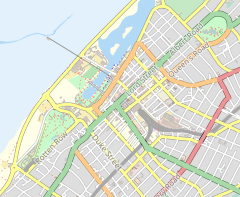Southport Winter Gardens
| Southport Winter Gardens | |
|---|---|
| Winter Gardens | |

Winter Gardens
|
|
|
Location within Southport town centre
|
|
| General information | |
| Type | Entertainment complex |
| Architectural style | Victorian Germano-Gothic |
| Address | Lord Street, Southport |
| Coordinates | 53°38′44″N 3°00′47″W / 53.645522°N 3.013033°W |
| Current tenants | Morrisons |
| Construction started | 1870 |
| Completed | 16 September 1874 |
| Demolished | 1933 & 1962 |
| Owner | various owners (majority Morrisons) |
| Height | 80 ft |
| Dimensions | |
| Other dimensions | 180 ft in length |
| Design and construction | |
| Architect | Maxwell & Tuke of Manchester |
The Southport Winter Gardens was a Victorian entertainment complex in the town of Southport, Merseyside. The original winter gardens comprised a theatre, opera house, aquarium, a small zoo, conservatory, promenades and halls situated under the grand glass domes.
The Winter Gardens were opened on 16 September 1874, on what was then the sea front at Southport. The building was in the form of two pavilions connected by a covered promenade, designed by Maxwell & Tuke of Manchester.
The building had two Germano-Gothic pavilions, one of which held a concert hall known as the 'Pavilion', while the other was the iron and glass Winter Garden (known as the 'Conservatory'). The Pavilion had a capacity for 2,500 people and the Winter Garden was a total 180 ft in length with a maximum height of 80 ft. (In comparison, the central section of the Kew Palm House is just over 137 ft long and 63 ft high.) Southport Winter Garden was advertised as the largest conservatory in England and being the first seaside Winter Garden in the UK. Refreshment rooms and an aquarium filled the basement level.
Although it was one of the biggest buildings ever to grace an English sea front, the Winter Garden was not a great commercial success. The Southport Pavilion and Winter Gardens Company, which promoted it was locally based and had wide support in the town and throughout the north-west with 350 shareholders at its peak, but the addition of Frank Matcham's Opera House on an adjacent site in 1890-91 strained the capital base too far, and the Company went into liquidation in 1898. Many companies rapidly came and went in an effort to save the Winter Gardens in an attempt to turn a profit. Entertainments were lost or driven downmarket, until the Winter Garden was converted into a ballroom and roller skating rink, and the Pavilion became a cinema. Eventually both were demolished, the Winter Garden in 1933 and the Pavilion in 1962.
The Opera House was built on Lord Street as an additional attraction to the main winter gardens complex. It opened on 7 September 1891 and was supported by leading dramatic companies in the area. It was designed by Frank Matcham, architect of many theatres in the United Kingdom. The building seated 2,000 people and cost around £20,000 to build. At the time the Opera House theatre was considered nationally to be one of Matcham's finest creations. The venue was a great success and had many well known performers attend including Ellen Terry, Matheson Lang, Sir Henry Irving. In December 1929 a fire raged through the building completely destroying it.
...
Wikipedia

